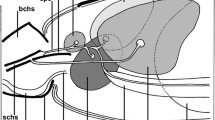Abstract
Synthesis and glycosylation of larval salivary gland secretory proteins of Chironomus thummi were analyzed with respect to cell specific differences in the Balbiani ring (BR) pattern and glycoprotein composition of secretion formerly detected by histochemical staining procedures. In the secretion of a special cell type in salivary glands, which is characterized by the appearance of an additional BR, an additional polypeptide with a relative molecular weight (Mr) of 160 kD was found differing in its antigenic properties and tryptic fingerprint pattern from main cell secretion proteins. This so-called ssp-160 component is preferentially synthesized and glycosylated in the special cells. In the same cells, both the synthesis and glycosylation of all other major secretory proteins was found to be diminished or even repressed. In contrast to the conspicuous cell-specific differences at the level of protein synthesis, RNA analyses show the prominent synthesis of 75 S RNA in both main and special cells and gave no clear indication of the synthesis of a smaller RNA fraction as expected from the size of ssp-160 component. — These and further data on synthesis and properties of secretory proteins as well as expression of BR DNA are discussed with regard to the assumption that at least some of the eight major secretory polypeptides are coded for by BR DNA. The BR gene(s) might have originated by manifold duplications and modifications of short repetitive prototype DNA sequences, which are coordinatively expressed.
Similar content being viewed by others
References
Agapova, O.A., Kiknadze, I.I.: Puffing and tissue-specific function of Chironomus thummi salivary gland cells. II. Comparative studies of cell ultrastructure of special and lateral salivary gland lobes. Cytology (USSR) 20, 1107–1111 (1978)
Ashburner, M., Bonner, J.J.: The induction of gene activity in Drosophila by heat shock. Cell 17, 241–254 (1979)
Beermann, W.: Ein Balbiani-Ring als Locus einer Speicheldrüsenmutation. Chromosoma (Berl.) 12, 1–25 (1961)
Case, S.T., Daneholt, B.: The size of the transcription unit in Balbiani ring 2 of Chironomus tentans as derived from analysis of the primary transcript and 75S RNA. J. molec. Biol. 124, 223–242 (1978)
Chamberlain, J.P.: Fluorographic detection of radioactivity in polyacrylamide gels with the water-soluble fluor, sodium salicylate. Analyt. Biochem. 98, 132–135 (1979)
Daneholt, B., Andersson, K., Fagerlind, M.: Large-sized polysemes in Chironomus tentans salivary glands and their relation to Balbiani ring 75S RNA. J. Cell Biol. 73, 149–160 (1977)
Edström, J.-E., Rydlander, L., Francke, C.: Concomitant induction of a Balbiani ring and a giant secretory protein in Chironomus salivary glands. Chromosoma (Berl.) 81, 115–124 (1980)
Elder, J.H., Pickett II, R.A., Hampton, J., Lerner, R.A.: Radioiodination of proteins in single polyacrylamide gel slices. Tryptic peptide analysis of all the major members of complex multicomponent systems using microgram quantities of total protein. J. biol. Chem. 252, 6510–6515 (1977)
Grossbach, U.: The salivary gland of Chironomus (Diptera): A model system for the study of cell differentiation. In: Biochemical differentiation in insect glands (W. Beermann, ed). Results and problems in cell differentiation, vol. 8, 147–196. Berlin, Heidelberg, New York: Springer 1977
Hertner, T., Meyer, B., Eppenberger, H.M., Mähr, R.: The secretion proteins in Chironomus tentans salivary glands: Electrophoretic characterization and molecular weight estimation. Roux's Arch. 189, 69–72 (1980)
Kiknadze, I.I., Valeeva, F.S., Vlasova, I.E., Panova, T.M., Sebeleva, T.E., Kolesnikov, N.N.: Puffing and specific function of salivary gland cells in Chironomus thummi. I. Quantitative changes of proteins and glycoproteins in salivary gland at different larval stages. Ontogenes (USSR) 10, 161–172 (1979)
Kopantzev, E.P., Karakin, E.I., Panova, T.M., Kiknadze, I.I.: The antigenes of the secretion of salivary glands from Chironomus thummi larvae. Proc. Natl. Acad. Sci. USSR (russ.) 249, 1477–1480 (1979)
Laemmli, U.K.: Cleavage of structural proteins during the assembly of the head of bacteriophage T4. Nature (Lond.) 227, 680–685 (1970)
Lamb, M.M., Daneholt, B.: Characterization of active transcription units in Balbiani rings of Chironomus tentans. Cell 17, 835–848 (1979)
Laurell, C.-B.: Antigene-antibody crossed electrophoresis. Analyt. Biochem. 10, 358–361 (1965)
Pankow, W., Lezzi, M., Holderegger-Mühling, I.: Correlated changes of Balbiani ring expansion and secretory protein synthesis in larval salivary glands of Chironomus tentans. Chromosoma (Berl.) 58, 137–153 (1976)
Rydlander, L., Edström, J.-E.: Large sized nascent protein as dominating component during protein synthesis in Chironomus salivary glands. Chromosoma (Berl.) 81, 85–99 (1980)
Rydlander, L., Pignon, A., Edström, J.: Sequences translated by Balbiani ring 75S RNA in vitro are present in giant secretory protein from Chironomus tentans. Chromosoma (Berl.) 81, 101–113 (1980)
Sebeleva, T.E., Kiknadze, I.I.: The cytochemical analysis of mucopolysaccharide secretion in the salivary glands of Chironomus thummi larvae. Cytology (USSR) 19, 147–153 (1977)
Serfling, E.: The transcripts of Balbiani rings from Chironomus thummi. Chromosoma (Berl.) 57, 271–283 (1976a)
Serfling, E.: Studies on the lability of dipteran 28S ribosomal RNA: The formation of the breakpoint of 28S rRNA is a cytoplasmic event. Biol. Zbl. 95, 713–723 (1976b)
Serfling, E., Huth, A.: Balbiani ring RNA in cytoplasm of Chironomus thummi salivary gland cells. Chromosoma (Berl.) 66, 205–223 (1978)
Wobus, U., Bäumlein, H., Panitz, R., Serfling, E., Kafatos, F.: Periodicities and tandem repeats in a Balbiani ring gene. Cell 22, 127–135 (1980)
Wülker, W., Götz, G.: Die Verwendung der Imaginalscheiben zur Bestimmung des Entwicklungszustandes von Chironomus-Larven (Diptera). Z. Morphol. Tiere 62, 363–388 (1968)
Author information
Authors and Affiliations
Additional information
On the occasion of the 60th anniversary of his birth-day we wish to dedicate this paper to Professor Wolfgang Beermann who was the first to detect, by the discovery of cell specific expression of BR 4 of Chironomus pallidivittatus salivary gland chromosomes and the concomitant occurrence of cell specific secretion granules, a causual relationship between the activity of a Balbiani ring and the appearance of a secretion component (Beermann, 1961)
addressee for reprint requests
Rights and permissions
About this article
Cite this article
Kolesnikov, N.N., Karakin, E.I., Sebeleva, T.E. et al. Cell-specific synthesis and glycosylation of secretory proteins in larval salivary glands of Chironomus thummi . Chromosoma 83, 661–677 (1981). https://doi.org/10.1007/BF00328525
Received:
Issue Date:
DOI: https://doi.org/10.1007/BF00328525




